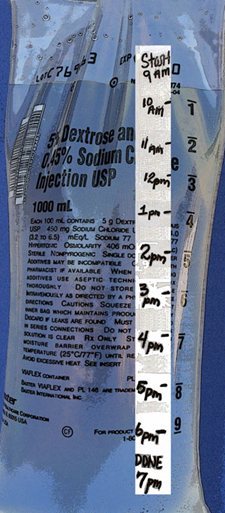It is the nurse’s responsibility to make sure fluids will infuse at the prescribed rate, in accordance with the provider’s orders. While IV fluids may be infused by gravity and controlled manually, the use of an infusion pump is usually recommended. Either way, you will be responsible for calculating the correct rate of infusion, and ensuring the fluid infuses at the correct rate.
Use the following mathematical formula to determine IV flow rates in drops per minute (gtt/min):
Where volume is the amount of fluid in the IV bag, time is total number of minutes the fluid is to infuse over, and the drop factor (or drip factor) is related to the size of the IV tubing you are using; the number of drops per mL delivered for a particular drip chamber. All microdrip tubing delivers 60 gtt/mL and is used to deliver a small or very precise amount of fluid. Macrodrip tubing delivers between 10 gtt/mL and 15 gtt/mL and is used to administer large volumes of fluid or to infuse fluid quickly. The calibration should be prominent on the tubing packaging. Double check before performing your calculation.
Try these examples:
Example #1: The provider has ordered 1,000 mL 0.9% sodium chloride to infuse over 8 hr. You have a macrodrip tubing with a drop factor of 15 gtt/mL available. Calculate how many gtt/min to set as the IV flow rate.
Solution #1:
Remember that time is in minutes, so you must convert hours to minutes. Since there are 60 minutes in one hour, multiply by the number of hours by 60 to figure out the time in minutes.
The true answer is just over 31 gtt/min. However, it is impossible to visualize 0.2 gtt/min. Therefore, it is widely accepted to round to the nearest whole number.
Example #2: The provider has ordered ranitidine (Zantac) 50 mg in 100 mL 0.9% sodium chloride intravenous piggyback to be infused over 20 min. You have a macrodrip tubing with a drop factor of 10 gtt/mL. Calculate how many gtt/min to set as the IV flow rate.
Solution #2:
When using an infusion pump, you will need to set the pump to a rate of flow, usually in mL per hour. The calculations are similar to regulating the flow with the roller clamp. However, there is no need to factor in the size of the drop set, as the pump is able to make that calculation for you. Convert minutes to hours by multiplying 60 minutes in one hour. Here is the modified and simplified formula:
Example #3: The provider has ordered 600 mL of 5% dextrose in water to infuse over 8 hr. Determine how many mL/hr to set the IV pump to deliver.
Solution #3:
Example #4: The provider has ordered amiodarone (Cordarone) 300 mg in 100 mL to be infused over 30 min. Determine how many mL/hr to set the IV pump to deliver.
Solution #4:
After you’ve completed your calculations and before you start the infusion, mark the bag of fluids with adhesive tape or a commercially available time tape next to the volume gradations on the bag. Having a time tape properly installed will help you quickly determine if the fluids are infusing over the correct period of time. Time tape can also help you determine if the IV line has infiltrated, or if the line or catheter has become occluded.








